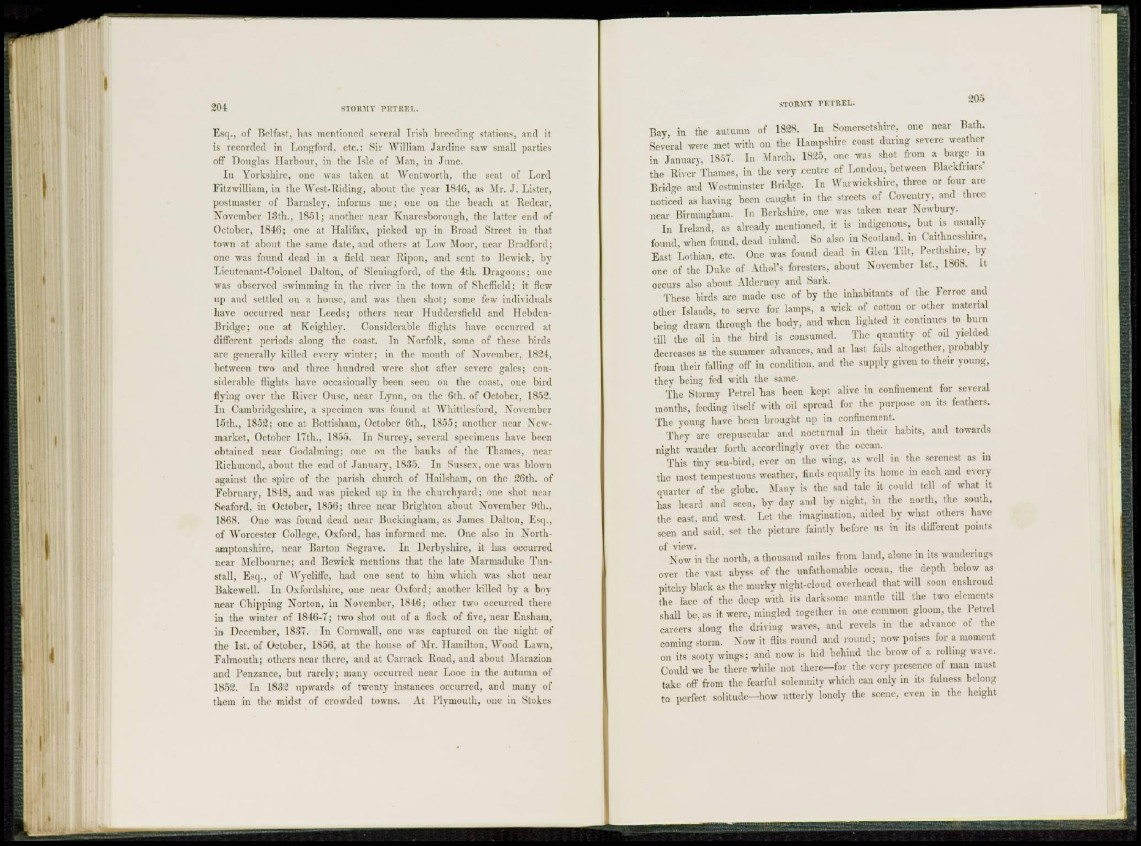
Esq., of Belfast, has mentioned several Irish breeding stations, and it
is recorded in Longford, etc.: Sir William Jardine saw small parties
off Douglas Harbour, in the Isle of Man, in June.
I n Yorkshire, one was taken at Wentworth, the seat of Lord
Fitzwilliam, in the West-Riding, about the year 1846, as Mr. J. Lister,
postmaster of Barnsley, informs me; one on the beach at Redcar,
November 13th., 1851; another near Knaresborough, the latter end of
October, 1846; one at Halifax, picked up in Broad Street in (hat
town at about the same date, and others at Low Moor, near Bradford;
one was found dead in a field near Ripon, and sent to Bewick, by
Lieutenant-Colonel Daltou, of Sleniugford, of the 4th. Dragoons; one
was observed swimming in the river in the town of Sheffield; it flew
up and settled on a house, and was then shot; some few individuals
have occurred near Leeds; others near Huddersfield and Hebdcn-
Bridge; one at Keighley. Considerable flights have occurred at
different periods along the coast. In Norfolk, some of these birds
are generally killed every winter; in the month of November, 1824,
between two and three hundred were shot after severe gales; considerable
flights have occasionally been seen on the coast, one bird
flying over the River Ouse, near Lynn, on the 6th. of October, 1852.
I n Cambridgeshire, a specimen was found at Whittles ford, November
15th., 1852; one at Bottisham, October 6th., 1855; another near Newmarket,
October 17th., 1855. In Surrey, several specimens have been
obtained near Godalming; one on the banks of the Thames, near
Richmond, about the end of January, 1835. In Sussex, one was blown
against the spire of the parish church of Hailsham, on the 26th. of
February, 1848, and was picked up in the churchyard; one shot near
Seaford, in October, 1856; three near Brighton about November 9th.,
1868. One was found dead near Buckingham, as James Dalton, Esq.,
of Worcester College, Oxford, has informed me. One also in Northamptonshire,
near Barton Segrave. In Derbyshire, it has occurred
near Melbourne; and Bewick mentions that the late Marmaduke Tunstall,
Esq., of Wycliffe, had one sent to him which was shot near
Bakewell. In Oxfordshire, one near Oxford; another killed by a boy
near Chipping Norton, in November, 1846; other two occurred there
in the winter of 1846-7; two shot out of a flock of five, near Ensham,
in December, 1837. In Cornwall, one was captured on the night of
the 1st. of October, 1856, at the house of Mr. Hamilton, Wood Lawn,
Falmouth; others near there, and at Carrack Road, and about Marazion
and Penzance, but rarely; many occurred near Looe in the autumn of
1852. In 1832 upwards of twenty instances occurred, and many of
them in the midst of crowded towns. At Plymouth, one in Stokes
Bay, in the autumn of 1S2H. In Somersetshire, one near Bath.
Several were met with on the Hampshire coast during severe weather
in January, 1857. In March, 1825. one was shot from a barge in
the River Thames, in the very .centre of London, between Blackfriars'
Bridge and Westminster Bridge. In Warwickshire, three or four are
noticed as having been caught in the streets of Coventry, and three
near Birmingham. In Berkshire, one was taken near Newbury.
In Ireland, as already mentioned, it is indigenous, but is usually
found, when found, dead inland. So also in Scotland, in Caithnesshire,
East Lothian, etc. One was found dead in Glen Tilt, Perthshire, by
one of the Duke of Athol's foresters, about November 1st., 1868. It
occurs also about Aldcrney and Sark.
These birds are made use of by the inhabitants of the Ferroe and
other Islands, to serve for lamps, a wick of cotton or other material
being drawn through the body, and when lighted it continues to burn
till the oil in the bird is consumed. The quantity of oil yielded
decreases as the summer advances, and at last fails altogether, probably
from their falling oil" in condition, and the supply given to their young,
they being fed with the same.
The Stormy Petrel h a s been kept alive in confinement for several
months, feeding itself with oil spread for the purpose on its feathers.
The voung have been brought up in confinement.
They are crepuscular and nocturnal in their habits, and towards
night wander forth accordingly over the ocean.
This tiny sea-bird, ever on the wing, as well in the sereneai as in
the most tempestuous weather, finds equally its home in each and every
quarter of the globe. Many is the sad tale it could tell of what it
has heard and seen, by day and by night, in the north, the south,
the east, and west. Let the imagination, aided by what others have
seen and said. *et the picture faintly before us in its different points
of view.
Now in the north, a thousand miles from laud, alone in its wanderings
over the vast abyss of the unfathomable ocean, the depth below as
pitchy black as the murky night-cloud overhead that will soon enshroud
the face of the deep with its darksome mantle till the two elements
shall be, as it were, mingled together in one common gloom, the Petrel
careers along the driving waves, and revels in the advance of the
coming storm. Now it flits round and round; now poises for a moment
on its sooty wings; and now is hid behind the brow of a rolling wave.
Could we be there while not there—for the very presence of man must
take off from the fearful solemnity which can only in its fulness belong
to perfect solitude—how utterly lonely the scene, even in the height